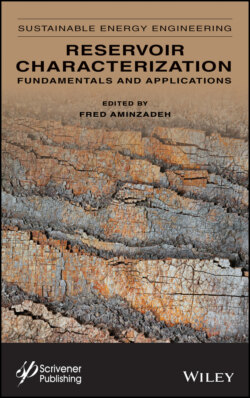Читать книгу Reservoir Characterization - Группа авторов - Страница 15
1.1 Introduction to Reservoir Characterization?
ОглавлениеAs discussed in Aminzadeh and Dasgupta [2], Reservoir Characterization is to assess reservoir condition and its properties using the available data from core/log data to seismic and production data. This is done to assist in delineating or describing a reservoir. Reservoir characterization and modeling have become increasingly important for optimizing field development.
Reservoir valuation and producing from a field demands a realistic description of the reservoir, requiring an integrated reservoir characterization and modeling. An integrated approach for reservoir modeling bridges the traditional disciplinary divides and tears down interdisciplinary barriers, leading to better handling of uncertainties and improvement of the reservoir model for field development. Integrated reservoir management requires better characterization of the reservoir and it is imperative to a successful operation throughout the life of the reservoir. Dynamic reservoir characterization is to understand the changes in reservoir properties to monitor its performance as we produce from reservoir and/or stimulate the reservoir to enhance production. This is accomplished by the analysis of data from combination of different sources, to extract additional information about the in-situ conditions of the reservoir, including the formation temperature, pressure, and the properties of the oil, gas, and brine. Other reservoir properties that can affect measured data are density, hydrocarbon viscosity, stresses, and fractures. We start with the reservoir description process that generates models of reservoir architecture, lithologies and facies. The geometry of the flow units is established, physical rock properties such as porosities and permeabilities of flow layers. Three properties are related to the pore space: porosity--the fraction of the entire volume part occupied by pores, cracks and fractures, internal surface: the magnitude of the surface of pores as related to the rock mass pore volume and controls interface-effects at the boundary grain - pore fluid, permeability: the ability to flow fluid through rock pores. Porosity and specific internal surface are scalar properties, permeability is a tensor.
Figure 1.1 shows integration of reservoir structure or architecture and reservoir detailed properties from calibration with well data for the reservoir model. Reservoir description is an iterative process and need.
Different aspects of Figure 1.1, from the input data to the process (well data, seismic data, production data, etc.) will be discussed in Section 1.2 on the data requirements. The difficulties associated with the integration of different data sources will be addressed in Section 1.3, under “SURE Challenge”. In Section 1.4 we discuss different aspects of reservoir characterizations fin different stages of reservoir life. The exploration and development stage deal with preliminary determination of the reservoir structural model, stratigraphic and facies models. This is followed by the production phase with a focus on porosity, permeability and fluid saturation, involving reservoir/flow simulation and history matching. The recovery stages involve injection of water/CO2 or steam to increase production. We discuss Dynamic Reservoir Characterization (DRC) in Section 1.5. We note that 4D seismic and microseismic data play an important role in geo-model updating monitoring production and the EOR/reservoir stimulation process. Sections 1.6 goes into more details on rock physics and reservoir modeling and how reservoir characterization can be used as an input to reservoir simulation and help with enhanced oil recovery and other well stimulation processes.
Figure 1.1 Different components of reservoir characterization, from Fornel and Estublier [5].
